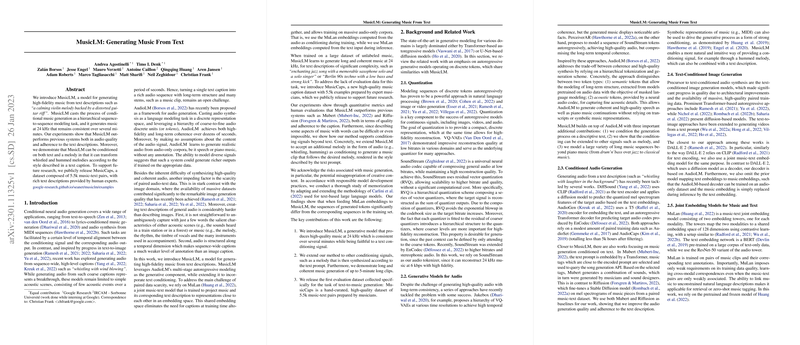Analyzing "MusicLM: Generating Music From Text"
The paper "MusicLM: Generating Music From Text" presents a novel approach to music generation through the integration of advanced generative models. The focus is the creation of MusicLM, a model adept at producing high-fidelity music from textual descriptions, leveraging both text and audio embeddings. This work builds upon several advancements in conditional audio generation and presents enhancements that address inherent challenges, such as maintaining audio quality and coherence over extended durations.
Methodology
MusicLM employs a hierarchical sequence-to-sequence approach. The methodology extends the concept of AudioLM, which treats audio generation as a LLMing task. The model uses an autoregressive process, integrating semantic and acoustic tokens derived from pre-trained models, specifically SoundStream and w2v-BERT. By utilizing MuLan embeddings for conditional input, MusicLM effectively bypasses the necessity for massive paired datasets during training.
A noteworthy innovation in this work is the hierarchical structuring into semantic and acoustic modeling stages, which allows the model to maintain temporal coherence and high fidelity. Semantic tokens facilitate long-term structure, while acoustic tokens deliver the finer audio details essential for quality.
Results and Evaluation
The paper's empirical results validate MusicLM's superiority over contemporary methods such as Mubert and Riffusion in both audio quality and fidelity to text prompts. Through quantitative measures like the Fréchet Audio Distance and qualitative assessments from human listeners, MusicLM demonstrates improved adherence to text descriptions, judged through extensive evaluations on the MusicCaps dataset.
MusicCaps itself is a significant contribution, developed as part of this research to provide high-quality text descriptions of music clips, aiding in both the training and evaluation of music generation models.
Importantly, the research presents a thorough validation of MusicLM’s capacity to balance quality and coherence, highlighting the statistical and perceptual strengths through innovative metrics like MuLan Cycle Consistency.
Implications and Future Directions
The implications of this research span both theoretical and practical domains. Theoretically, MusicLM advances the understanding of multi-modal embeddings in generative contexts, demonstrating the feasibility of conditionally generating diverse and complex audio outputs from richly descriptive text prompts. Practically, this model paves the way for applications in music production, content creation, and interactive media, where user-generated textual content can directly inform audio outputs.
Future research might delve into expanding MusicLM capabilities to include more intricate structural elements of music, like varying song components (introduction, verse, chorus), or integrating lyrics generation. Addressing limitations in negation and temporal ordering within text prompts remains an open challenge. The model's propensity towards cultural biases due to data-driven constraints also warrants careful consideration, particularly in ensuring equitable application across diverse cultural contexts.
In summary, MusicLM represents an advanced step in text-conditioned music generation, exhibiting robust quality and alignment with complex text descriptions. This work, underpinned by the release of MusicCaps, positions itself as a cornerstone for future innovations and enhancements in AI-driven music synthesis, setting a definitive benchmark for subsequent research in this dynamic field.
